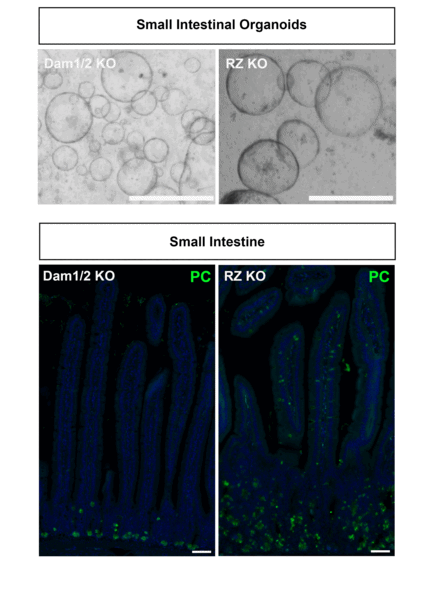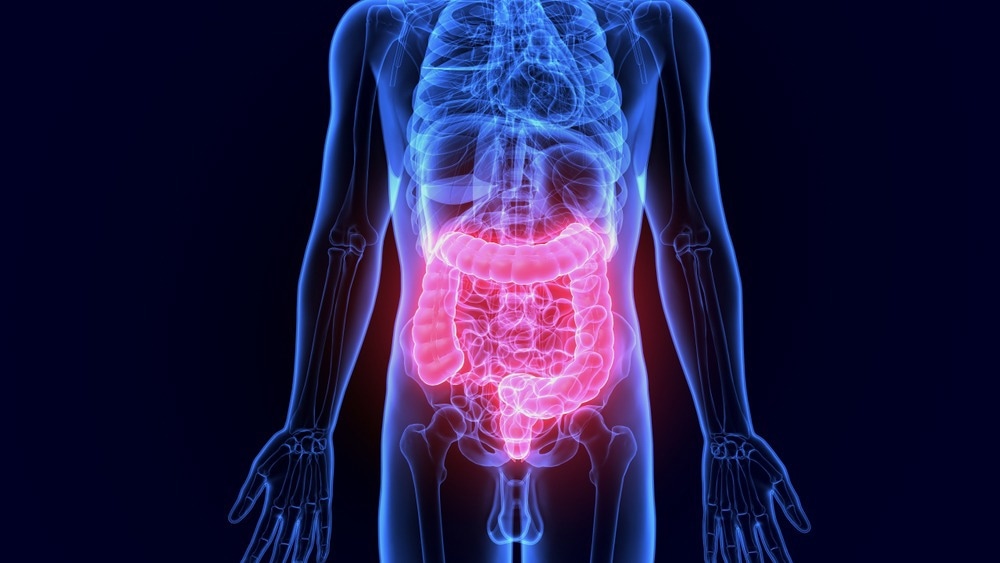Reviewed by Danielle Ellis, B.Sc.Nov 27 2023
Stem cells possess the remarkable ability to differentiate and replace deceased or impaired cells within the body.
 Top: Intestinal stem cells lacking Daam1 (left) or Rnf43 (right) form tumor-like organoids. Bottom: Intestines lacking Daam1 do not form ectopic Paneth cells, a type of secretory cells (left), while intestines lacking Rnf43 form ectopic Paneth cells (green, right). Image Credit: Gabriele Colozza/IMBA.
Top: Intestinal stem cells lacking Daam1 (left) or Rnf43 (right) form tumor-like organoids. Bottom: Intestines lacking Daam1 do not form ectopic Paneth cells, a type of secretory cells (left), while intestines lacking Rnf43 form ectopic Paneth cells (green, right). Image Credit: Gabriele Colozza/IMBA.
However, the intricate process through which stem cells determine their specific cell fate in a given context has long been a subject of inquiry. In a significant breakthrough, the research team led by Bon-Kyoung Koo at IMBA and the Institute for Basic Science uncovered a novel gene, Daam1, pivotal in activating the development of secretory cells in the intestine.
This groundbreaking discovery, unveiled in the study performed not only sheds light on the fundamental mechanisms governing cell differentiation but also introduces promising avenues for exploration in the realm of cancer research.
The study has been reported in the journal Science Advances on November 24th, 2023.

Image Credit: Life science/Shutterstock.com
Analogous to the routine maintenance required by automobiles, the human body necessitates periodic inspection and repair to sustain optimal functionality.
In the human body, the replacement of damaged or expired cells is orchestrated by tissue-resident adult stem cells. Unlike their embryonic counterparts, which possess the capacity to give rise to any cell type in the body, adult stem cells exclusively generate cell types native to the tissue they inhabit.
The intriguing question of how tissue-specific stem cells discern the appropriate cell type for regeneration prompted Gabriele Colozza, a postdoctoral researcher in Bon-Kyoung Koo's lab at IMBA (now serving as Director at the Center for Genome Engineering, Institute for Basic Science in South Korea), to delve into this scientific inquiry.
Colozza focused on unraveling the mysteries surrounding intestinal stem cells to uncover the intricate orchestration of cell fate determination within the context of tissue-specific stem cell biology.
Intestines–A constant construction site
Colozza explained, “In our intestines, cells are exposed to extreme conditions.”
Intestinal cells experience the impact of mechanical wear and tear, digestive enzymes, and fluctuating pH values. Consequently, the stem cells located in the mucosa of the intestine undergo differentiation to generate fresh intestinal cells.
Damaged cells have to be replaced, but it is a delicate balance between stem cell renewal and differentiation into other cell types: uncontrolled stem cell proliferation may lead to tumor formation; on the other hand, if too many stem cells differentiate, the tissue will be depleted of stem cells and ultimately unable to self-renew.”
Gabriele Colozza, Postdoctoral Researcher, Institute of Molecular Biotechnology of The Austrian Academy of Sciences
The equilibrium is intricately adjusted through signaling pathways and feedback loops, facilitating communication between cells.
An essential pathway in this context is the Wnt pathway, renowned for its involvement in embryonic development. When unregulated, an excessively active Wnt pathway can result in heightened cell division and the emergence of tumors.
Molecular Partner Identified
Rnf43, a recognized inhibitor of Wnt signaling that effectively restrains Wnt activity, was initially discovered by Bon-Kyoung Koo. Before the current investigation, the identified role of Rnf43 involved targeting the Wnt receptor Frizzled and tagging it for degradation.
“We wanted to know how Rnf43 works, and also what – in turn – controls Rnf43 and helps it to regulate Wnt signaling. In our project, we used biochemical assays to identify which proteins interact with Rnf43.” Previous research findings indicated that Rnf43 alone lacked the capability to degrade the Wnt receptor Frizzled, situated in the plasma membrane. The protein Daam1 emerged as a crucial collaborator of Rnf43.
To comprehend the regulatory role of Daam1 on Rnf43 and its impact on the relevant tissues, Colozza employed intestinal organoids.
We found that Daam1 is required for Rnf43 to be active, so for Rnf43 to regulate Wnt signaling at all. Further work in cells showed Rnf43 needs Daam1 to move the Wnt receptor Frizzled into vesicles called endosomes. From the endosomes, Frizzled is shuttled to the lysosomes where it is degraded, dampening Wnt signaling.”
Gabriele Colozza, Postdoctoral Researcher, Institute of Molecular Biotechnology of The Austrian Academy of Sciences
Cultivated from adult intestinal stem cells, intestinal organoids represent three-dimensional cell cultures that enable researchers to replicate the conditions of the intestinal mucosa. For Colozza, these organoids provided a valuable platform to investigate the influence of Rnf43 and Daam1 on the intricate equilibrium between stem cell renewal and differentiation in the intestine.
We found that when we knock-out Rnf43 or Daam1, the organoids grow into tumor-like structures. These tumor-like organoids keep on growing, even if we withdraw the growth factors they usually depend on, such as R-spondin.”
Gabriele Colozza, Postdoctoral Researcher, Institute of Molecular Biotechnology of The Austrian Academy of Sciences
Switching on paneth cell formation
Upon further investigation of this outcome in mouse tissue, the researchers encountered an unexpected revelation.
Colozza added, “When Rnf43 was missing, the intestines grew tumors – as expected. But when Daam1 was missing, no tumors grew. We were puzzled by this striking difference: how can the loss of factors in the same pathway, that behave similarly in organoids, lead to such different outcomes?”
Upon close examination of the intestines, Colozza observed that intestines deficient in Rnf43 were abundant in a distinct variety of secretory cells known as Paneth cells. Conversely, intestines lacking Daam1 did not exhibit any excess Paneth cells. Paneth cells play a role in secreting growth factors, such as Wnt, which stimulate cell division.
Colozza stated, “Daam1 is required for the efficient formation of Paneth cells. When Daam1 is active, stem cells differentiate to form Paneth cells. When Daam1 is not active, the stem cells differentiate into another cell type.”
Tumors modify their niche to grow
The connection between the molecular findings and the abundance of Paneth cells clarifies the perplexing distinction between intestines and organoids.
Colozza added, “In organoid culture, we scientists provide growth factors, so the knockout of both Rnf43 and Daam1 lead to tumor-like organoids. But in the intestine, there is no little scientist providing growth factors. Instead, Paneth cells provide growth factors, like Wnt, and create the right conditions for stem cells to survive and divide.”
“When Paneth cells are lacking – such as when Daam1 is not active to drive cells into becoming Paneth cells – stem cells will not divide much. But when there are too many Paneth cells – such as in intestines lacking Rnf43 – the excessive growth factors can contribute to the formation of tumors,” notes Colozza.
Colozza’s and colleagues’ study represents the inaugural genetic evidence affirming the significance of Daam1, a component of the non-canonical Wnt pathway, in the specification of Paneth cells and its direct involvement in the development of this vital secretory cell. The findings also illuminate the critical role of the stem cell niche.
Colozza added, “We show that tumor cells modify their microenvironment, and influence their supporting environment so that they can grow better.”
Source:
Journal reference:
Colozza, G., et al. (2023) Intestinal Paneth cell differentiation relies on asymmetric regulation of Wnt signaling by Daam1/2. Science Advances. doi.org/10.1126/sciadv.adh9673.